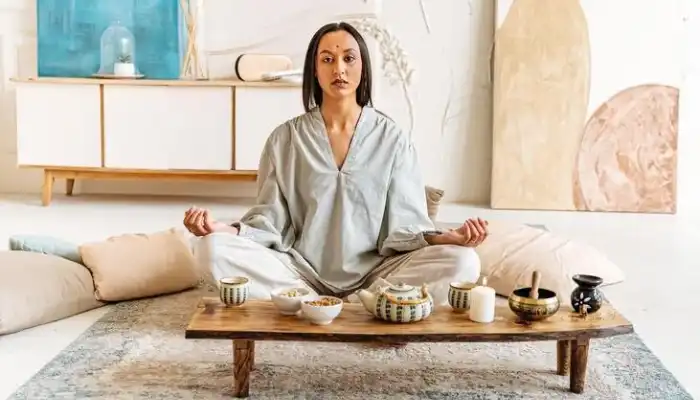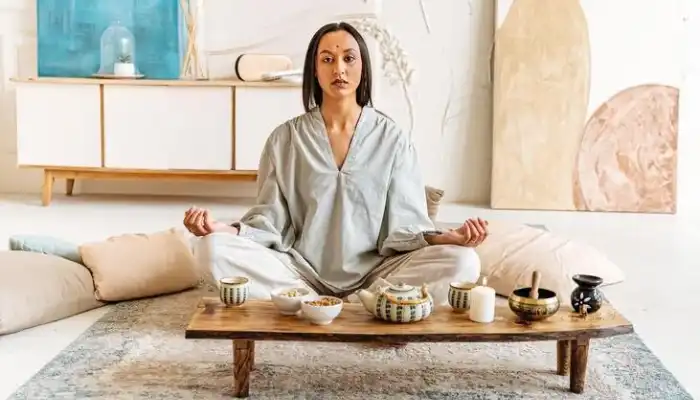
In today’s fast-moving world, finding moments of peace can seem like an irrelevant luxury. Meditation provides a potent means to develop inner tranquility, decrease stress levels, and enhance concentration. But how do you create a more meditative atmosphere? Your own home! This guide will show you how to transform your meditation space into your personal haven; a sanctuary that helps you go inside yourself.

Choosing the Right Location: Finding Your Inner Oasis
The location is the base of your meditation space. These are some important considerations:
- Peace: Choose a place away from distractions like noise or interruptions. A spare room, a quiet corner in your living room, or even a sunroom might work well for this purpose. When possible pick up a room that can be closed off with doors to have more privacy while practicing.
- Natural Light and Fresh Air: It would be ideal if you chose bright spots with an abundance of natural light. Sunlight is known for its uplifting effect on mood and it can also contribute to feelings of serenity. Moreover, strive for good air circulation wherever possible because it facilitates alertness and focus which makes meditation easier.
- Utilizing Unused Corners or Rooms: Do not have an extra room? No fuss at all! Be imaginative enough to change an unused nook or corner into your dream meditation area. Such places as a quiet alcove near a window, under the stairs or even part of a walk-in closet may become quite soothing when decluttered and made personal.
Declutter and Simplify: Creating a Space for Clarity
A cluttered environment can distract visually busy one from his/her practice by providing him/her visual distractions when he/she tries to turn his/her attention inwardly. Below are tips on creating a space that promotes better mental clarity:
- The Power of Decluttering: Get rid of any furniture and personal items that are not needed in the room. This way, you can minimize distractions and focus more on your inner self.
- Organize for Tranquility: Having designated storage solutions for meditation props and cushions keeps the space tidy and promotes a sense of order. Baskets, ottomans with hidden compartments, or simple shelves can be useful in organizing things.
- Embrace Minimalism: Keep surfaces clear of clutter and limit decorations to a few. A sense of spaciousness and calmness can be created through clean lines and uncluttered walls.
Set the Mood with Lighting and Color: A Visual Invitation to Calm
Lighting and color play an important role in creating the right atmosphere during meditation. Below is how to use lighting and color to create a calm environment:
- The Power of Lighting: Overhead lights that are too harsh may disrupt your practice. Rather, go for gentle natural light sources wherever you can find them. Use floor lamps whose brightness could be adjusted or table lamps placed around strategically to help you create warm inviting atmospheres.
- Harnessing Natural Light: Place your meditation area near a window to enjoy natural light during the day. Sunlight enhances wellbeing as well as alertness making it perfect for daytime practices.
- Choosing Calming Colors: Surround yourself with colors that evoke peace and tranquility within you. Soft greens, blues, and neutrals are popular choices for this purpose. Additionally, consider integrating materials such as wood or stone into your design scheme for added grounding effects. By experimenting with different color combinations, you will find what resonates most strongly with you which also creates a serene vibe.
Incorporate Comfortable Seating: Your Throne for Inner Peace
It is important to find the right meditation posture for a successful practice. The following are some options that can be considered for comfortable seating:
- The Old Standby: Zafu and Zabuton: A zafu, which is a round hard cushion used for meditation, slightly raises your hips so that the spine is in proper alignment. The zabuton, a flat square cushion placed beneath, adds comfort to your knees and ankles.
- A Familiar Option: Yoga Mats or Blankets: If you’re already a yogi or prefer a familiar feel, place down a blanket or yoga mat that’s folded up. Choose one with enough padding for your ankles and knees.
- Back Support for Upright Meditators: Benches and Chairs: For people who are comfortable sitting on the floor but prefer an upright position as well as those unable to sit at all on the floor due to physical limitations, meditation chairs and benches offer alternative seating options. Good models should have ergonomic designs that support the back of users with slightly slanted seat pans that promote correct spinal posture.
Creating a Cozy Ambiance: Apart from their functional roles in seating arrangements, there are other items you could include to make it cozy and warm. To keep yourself warm, drape yourself with a soft throw blanket, use sheepskin rugs then put your timer here, or maybe you could lay down your book.
Add Natural Elements: Embrace the Earth’s Tranquility
Connecting with nature during meditation can enhance your sense of peace and well-being. Here’s how to incorporate the calming power of nature into your space:
- Bring the Outdoors In: Decorate with houseplants that not only purify the air but also add a touch of life and vibrancy. Opt for low-maintenance plants like snake plants, spider plants, or peace lilies.
- Natural Materials: Surround yourself with natural materials like wood, stone, bamboo, or cotton. These elements create a sense of grounding and connection to the earth.
- Soothing Soundscapes: Consider incorporating the sounds of nature, such as babbling brooks, ocean waves, or gentle rain, into your meditation practice. These calming sounds can mask external noise and enhance your focus.
Remember: Even a small potted plant or a woven basket can connect you to the natural world and enrich your meditation space.
Personalize with Meaningful Decor: A Reflection of You
Your meditation space should be a unique reflection of your inner world. Here’s how to strike the perfect balance between personalization and maintaining a sense of calm:
- A Story Through Objects: Tell your story through items that hold special meaning. This might include something like a favorite art piece that inspires peace in you, perhaps a shell from a memorable vacation, or even something passed down over generations. Surround yourself with uplifting things that make you happy.
- Curate, Don’t Crowd: However, personalization is important; avoid making clutter in the process. Too many objects can become visually distracting and defeat the purpose of creating a serene environment. Choose a few significant pieces that mean much more than what they appear like and arrange them thoughtfully.
- Inspiring Words and Images: Incorporate inspirational quotes, poems, and affirmations resonating with your meditation practice such as those beautiful words framed on walls, written on chalkboards, or calming pictures of mandalas and nature scenes.
Remember: Personalizing your space has no right or wrong answers for this matter. Let your gut feeling guide you in choosing things that inspire and uplift you along your path to meditative success.
Create a Sound Environment: Cultivating Aural Tranquility
In meditation, sound is very important. Here’s how to deal with outside noise and create a soundscape that promotes internal peace.
- Reduce external noise sources: If possible, pick a quiet place far from high-traffic areas or noisy appliances. In case of need, consider soundproofing techniques such as blackout curtains or noise-canceling headphones.
- Calm Soundscapes: Include calming sounds to improve your practice. Natural noises like babbling streams, ocean waves or soft rain can be highly effective. You can also try out instrumental music specifically created for meditation often with peaceful melodies and natural elements.
- Silence Speaks Louder than Words: At times complete silence would be the best soundscape, especially for experienced meditators. Try it out and find what works best for you.
Remember: The aim is to build a sonic environment that minimizes disruptions and enables you to concentrate inwards better.
Keep Cleanliness and Order: A Clear Space for a Clear Mind
Like physical clutter can be visually distracting, an untidy space for meditation will interfere with mental clarity. This is how you can maintain orderliness in your sanctuary:
- Develop A Cleaning Schedule: To keep your Meditation space dust-free and neat have some regular cleaning sessions scheduled. It does not mean deep cleaning every day but quick sweeping up, and removing any stray objects while wiping down surfaces can make a big difference.
- Designated Storage: if you use cushions, blankets, and yoga mats during meditation then establish specific storage locations where they should stay when not in use so that they are organized away from sight; this can include baskets cubbyholes, or even small cabinets to keep everything clean looking,
- Release What No Longer Serves You: Periodically go through the things in your meditation area; if something does not bring you joy any longer or serve any purpose get rid of it; free environments promote serenity and mental focus.
Remember: It is an ongoing practice to maintain a clean and organized space but it pays off for a more peaceful, focused meditation experience.
Conclusion
Making your own meditation space is a personal journey. Utilize the points covered in this manual to create an oasis that supports meditation and provides inner peace. Remember, there is no one size fits all. Experiment, personalize, and trust yourself as you create spaces that mirrors truly your inner world, where you can flourish in your meditation practice.
Do you have a dedicated meditation space? Share your tips and experiences in the comments below! We can all learn from each other on this journey towards inner peace.
